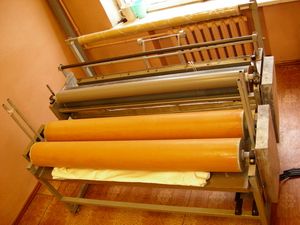Main Sector of relevance\IRC classification 7. Environment and Safety
7.16 Fibrous catalyst for hydrogen sulphide oxidation

Developers’ contact information
State Scientific Institution “The Institute of Physical Organic Chemistry of the National Academy of Sciences of Belarus”
13, Surganov Str., 220072 Minsk
Summary
Fibrous catalyst-absorbent is used for cleaning the air from toxic substances of hydrogen sulphide in different branches of economy.
Description
There has been developed fibrous composite material that can perform catalytic conversion of hydrogen sulphide in sulphur over a wide range of relative humidity of the cleaned air (40-95%), and hydrogen sulphide concentration (10 mcg/m3–70 mg/m3). Effective material meant for purification of air from hydrogen sulphide is produced as a result of coating the polymer base of fibrous ionites with active component alongside with the composition controlling moisture adsorption of the composite material. In the process of air purification the produced material ensures complete removal of hydrogen sulphide from the air under the conditions that are characteristic for practical use of that filter material in industrial filters designed for process air purification. The produced material also characterises by the absence of proper gas emissions due to its composition. Fibrous catalyst can be manufactured in two forms: 1) non-woven needle-punched fiber (rolls, width up to 160cm, thickness 3-10mm, surface density 400-1000g/m2, bulk density 0.1-0.2 kg/dm3, allows densification up to 0.5 kg/dm3, rolls length from 10 to 40 m); 2) staple fiber (single fiber diameter 40-70 mcm, single fiber length 40-70 mm).
Technology type
Technical advantages and economic benefits
Fibrous catalyst works productively over a wide range of relative humidity of cleaned air (40-95%) and hydrogen sulphide concentration (10 mcg/m3-70mg/m3).
Technology differentiation and uniqueness
Purification of air from hydrogen sulphide in the presence of macro quantities of carbon dioxide; effectively removes hydrogen sulphide with low concentrations (10-100 mcg/m3) from air.
Context in which technology was identified
—
Technological keywords
Fibrous catalyst, hydrogen sulphide, purification.
Development Stage
Intellectual property rights
Range of applications
Purification of process and ventilation air in production and living areas from hydrogen sulphide substances, means of individual protection, protection of high-technology equipment from hydrogen sulphide corrosion.
Classifier Used at the EU Innovation Relay Centres
Preferable Regions
Practical experience
—
Environmental impact
Do not affect the environment, meant to reduce emission of hydrogen sulphide substances in the air.
Type of collaboration sought
Terms and restrictions
Non-exclusive license contract
Available technical assistance